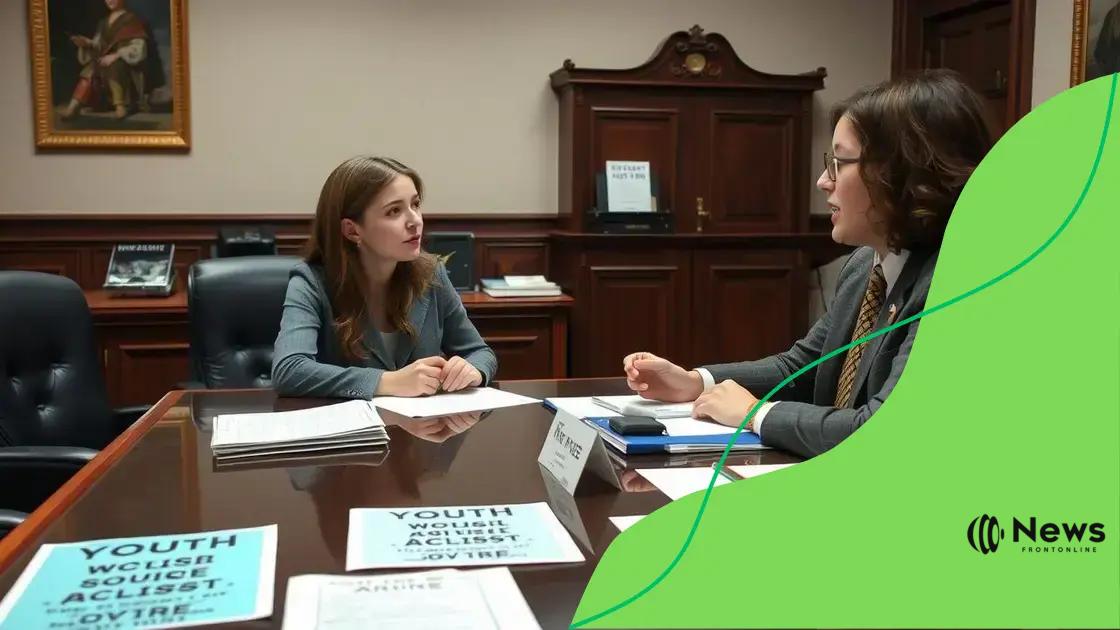Legislative reaction to Gen Z protests: what’s next?
The legislative reaction to Gen Z protests is reshaping policies as lawmakers respond to youth activism through increased engagement, new legislation, and a focus on social issues like climate change and gun control.
Legislative reaction to Gen Z protests is a crucial topic as younger generations make their voices heard. Have you wondered how these protests shape policies and society’s future? This article dives into the vibrant world of youth activism.
Understanding Gen Z: Motivations and Perspectives
Understanding Gen Z is essential to grasp their motivations and perspectives in today’s world. This generation, born roughly between 1997 and 2012, is known for being tech-savvy, socially conscious, and engaged in various societal issues. Their unique position as digital natives influences how they express their opinions, especially when it comes to activism.
Key Motivations of Gen Z
One of the main drivers for Gen Z is their desire for authenticity and social justice. They are informed by the constant flow of information from social media and other online platforms. Many Gen Z individuals engage in activism, motivated by personal experiences and the impact of social injustices. Issues such as climate change, racial equality, and mental health drive their passion to create change.
- Climate change awareness and action
- Advocacy for racial and gender equality
- Support for mental health initiatives
Additionally, Gen Z values diversity and inclusion, often prioritizing these aspects in their advocacy. They seek to uplift marginalized voices and challenge the status quo. Given their continuous exposure to global issues online, they cultivate a sense of responsibility to make a difference.
The Role of Technology in Shaping Perspectives
Technology plays a critical role in shaping Gen Z’s perspectives. Social media platforms, such as Instagram and TikTok, provide a space for them to share their views and connect with like-minded individuals. These platforms enable them to mobilize quickly for causes they believe in, demonstrating the power of their united voice.
Moreover, the prevalence of online petitions and fundraising campaigns reflects their proactive approach to enacting change. With just a click, they can support movements or donate to causes they care about. This accessibility allows them to feel involved and empowered, reinforcing their belief in collective action.
In summary, understanding Gen Z’s motivations and perspectives helps to shed light on their activism and legislative reactions. Their commitment to creating a better future underscores the importance of recognizing their impact on society.
Key protests and their impact on legislation
Key protests have played a significant role in influencing legislation in recent years. Movements led by Gen Z have emerged strongly, shining a light on various issues from climate change to social justice. Understanding these protests is vital to grasp how they shape policies in governmental spheres.
Examples of Significant Protests
One notable example is the Green New Deal protests, where young activists called for comprehensive action against climate change. These protests not only mobilized thousands but also pressured lawmakers to consider bold climate policies. Another critical moment was the March for Our Lives, which arose after tragic school shootings. This movement galvanized youth to advocate for stricter gun control measures, significantly impacting legislative discussions.
- Green New Deal: Focused on environmental policies and sustainability.
- March for Our Lives: Strived for gun control and safer schools.
- Black Lives Matter: Highlighted racial equality and police reform.
With social media as their platform, these protests quickly spread awareness and drew support across the globe. The hashtag campaigns brought together diverse communities, amplifying voices that might otherwise go unheard. As such, legislators are compelled to listen closely to the demands put forward during these events.
Legislative Changes Triggered by Protests
The influence of protests on legislation becomes evident when examining specific policy changes. For instance, after widespread protests regarding police brutality, several states initiated police reform bills. These bills aimed to increase accountability and transparency in law enforcement.
Similarly, the momentum created by climate protests has led to increased funding for renewable energy projects. Governments are now more likely to prioritize sustainability in their agendas. This shift shows how youth activism can sway political priorities and legislation.
Overall, the impact of key protests on legislation illustrates the power of collective action. By rallying around core issues, Protesters not only make noise but also drive real change, shaping the future of policy and governance.
Responses from lawmakers and institutions

Responses from lawmakers and institutions to Gen Z protests reveal a complex landscape. Many politicians have begun to take notice of the issues brought to light by young activists. This generation’s demands for change are hard to ignore, especially with their ability to drive public discourse through social media.
Engagement with Activists
Lawmakers are increasingly engaging with youth activists. Town halls and forums have become common spaces where young voices can be heard. For example, many representatives now hold meetings specifically focused on topics like climate change and gun control, addressing the concerns that Gen Z brings to the forefront.
- Involvement in legislative discussions
- Creation of youth advisory councils
- Partnerships with activist organizations
This shift signifies a recognition of the importance of youth in shaping policy. Lawmakers understand that ignoring Gen Z could result in a loss of support from the younger electorate.
Changes in Legislation
As protests gain momentum, more legislators are proposing new bills in response to Gen Z demands. Legislators are introducing policies aimed at strict gun control, heightened sustainability measures, and healthcare reforms influenced by young people’s views. These proposals often reflect key aspects highlighted during protests.
For instance, responses to the March for Our Lives have resulted in new regulations on firearm sales in several states. Additionally, climate protests have inspired renewed efforts towards renewable energy laws.
Institutions such as schools and universities are also adapting by incorporating discussions on social issues into their curricula. These changes reflect a broader commitment to prepare younger generations for civic involvement and activism.
Overall, the interaction between protests and legislative responses signifies a powerful cycle where both sides influence each other. The commitment to addressing the needs of Gen Z is reshaping policy and driving a historic shift toward a more inclusive political landscape.
The role of social media in activism
The role of social media in activism is significant in today’s world. Platforms like Twitter, Instagram, and TikTok enable activists to share their messages quickly and widely. For Gen Z, social media is not just a tool; it’s a crucial part of how they organize and participate in protests.
Immediate Communication
Social media allows for immediate communication about events and issues. When a protest is organized, information can spread rapidly through posts and hashtags. This real-time connectivity empowers young activists to mobilize their peers quickly. Rallying support becomes seamless, leaving less room for misinformation to propagate.
- Quick updates on protest details
- Live streaming events for wider reach
- Utilization of hashtags to unify voices
Many protests gain traction online before they even happen in real life. This pre-event buzz is vital for building momentum and drawing attention from the media and lawmakers.
Creating Awareness and Building Communities
Through social media, activists create awareness around critical issues like climate change, racial inequality, and mental health. Engaging content, including videos and graphics, can illustrate these issues vividly, reaching users who might not be aware of them otherwise. Young people increasingly use their platforms to educate others, encouraging conversations that can lead to action.
Moreover, social media helps build communities among activists. Online groups and forums foster connections between those sharing similar goals. This sense of community amplifies support and offers a space for collaboration.
In essence, social media bridges geographical gaps, allowing activists across the globe to connect. Whether sharing strategies, raising funds, or organizing events, these platforms are pivotal in the push for social change.
Future implications for youth involvement
Future implications for youth involvement in activism are significant. As Gen Z continues to assert their presence, their impact on society is likely to grow. More young people are becoming aware of the issues that affect them and are determined to push for change.
Increasing Political Engagement
One of the main implications is the rise in political engagement among youth. As they witness the outcomes of protests and movements, many young individuals are inspired to vote, run for office, or even work in advocacy. This wave of political activity may lead to more policies that reflect the values of younger generations.
- Higher voter turnout rates among young people
- More youth candidates in local and national elections
- Increased youth participation in political discussions
With more young people involved in politics, issues like climate change, education reform, and social justice are more likely to be prioritized.
Shaping Future Movements
Gen Z is also likely to shape future movements with their unique perspectives and methods of organizing. They utilize social media not just for spreading awareness, but also for building community. These tools can help them connect across distances and collaborate with others who share their goals. As they continue to innovate, new forms of activism will emerge, making it easier to gather support.
This adaptability is critical as society faces new challenges and shifts. For example, as technology evolves, the methods of organizing protests may change, potentially leading to more effective campaigns. Additionally, the trend of intersectionality in activism, where multiple social issues are tackled simultaneously, is expected to grow, creating a more holistic approach to activism.
As the world changes, the role of youth in advocacy and activism will become even more essential. Their drive for social justice, sustainability, and equity positions them as key players in shaping a better future.
As we conclude, it’s clear that the legislative reaction to Gen Z protests is reshaping our political landscape. The engagement of this generation in activism has driven lawmakers to pay attention to the issues they care about, leading to significant changes in policies and legislation. Social media plays a vital role in this process, allowing for quick organization and awareness-raising. Looking ahead, the continued involvement of youth promises to bring about more inclusive and responsive governance, ensuring that their voices remain pivotal in shaping the future. Together, they are not just advocating for change; they are making it happen!
FAQ – Frequently Asked Questions about Legislative Reactions to Gen Z Protests
How are Gen Z protests influencing legislation?
Gen Z protests are prompting lawmakers to pay closer attention to social issues, leading to new policies that reflect youth concerns.
What role does social media play in youth activism?
Social media serves as a vital tool for organizing, raising awareness, and connecting young activists, allowing for quick mobilization.
What are some significant issues Gen Z is advocating for?
Key issues include climate change, gun control, racial equality, and mental health, which young activists are passionate about.
How can young people further their involvement in activism?
Young people can increase their involvement by voting, participating in local meetings, and engaging in discussions about social issues.





